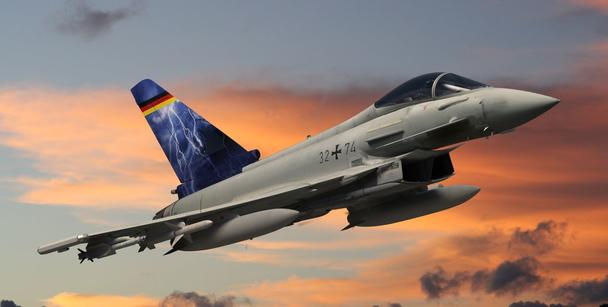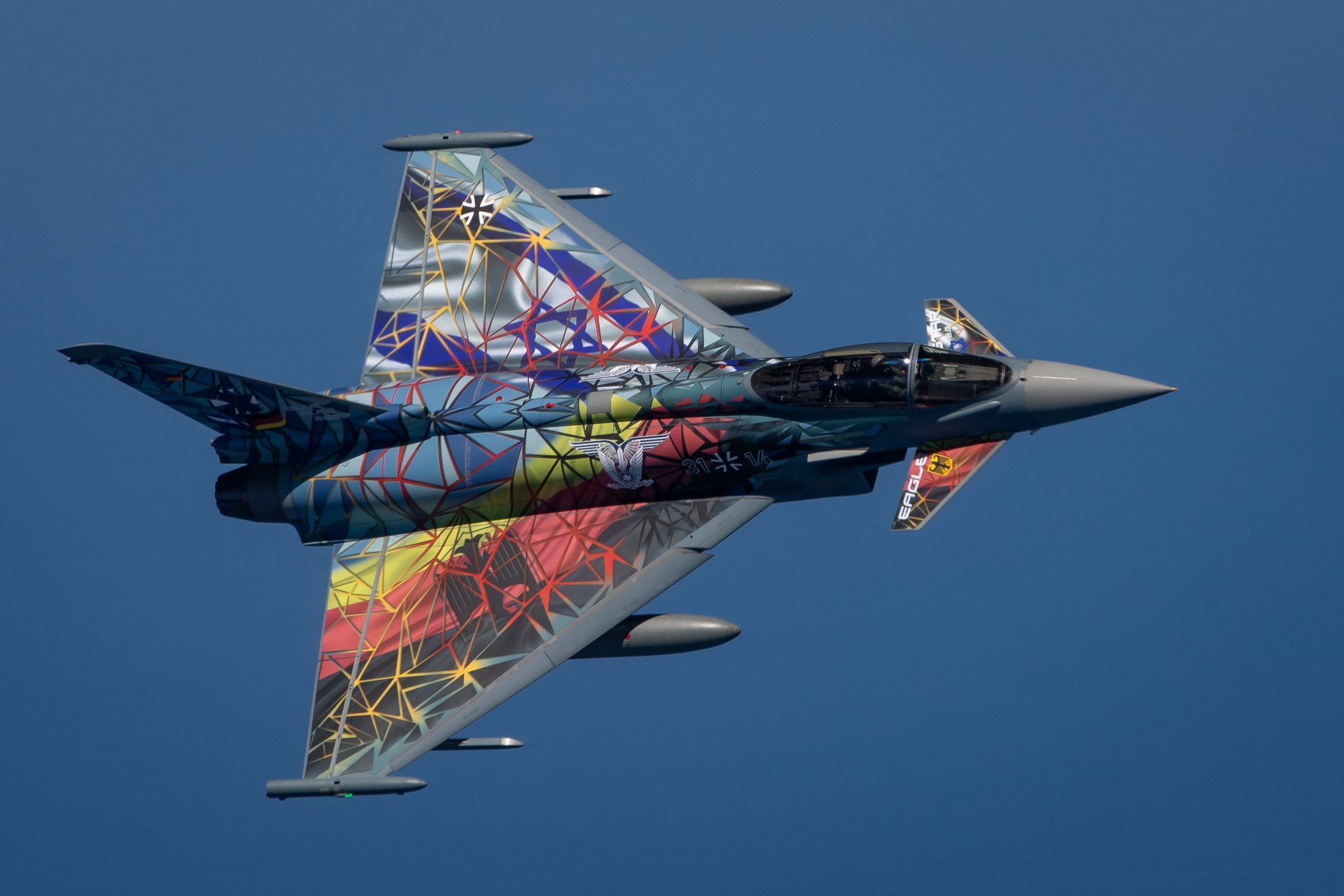The German Air Force, known as Luftwaffe, has officially decided to convert 15 Eurofighter Typhoon fighter jets into electronic warfare aircraft capable of breaking radar detection range. Eurofighter Typhoons, across different upgraded variants, currently form the backbone of the Luftwaffe.
Mission ‘Not Impossible’: USAF Stitching Two F-35s Into A Fully Operational F-35A Lightning II Jet
With parliamentary permission from the Budget Committee, Germany is scheduled to replace its Tornado electronic combat/reconnaissance (ECR) aircraft with Eurofighter Typhoon Elektronischer Kampf (EK), especially for conducting suppressing enemy air defense (SEAD) missions.
Codenamed as Eurofighter Typhoon EK, the aircraft will be equipped with the supersonic, medium-range, air-launched tactical missile Northrop Grumman/MBDA’s AGM-88E Advanced Anti-Radiation Guided Missile (AARGM), a missionized pod, and Saab’s Alexis Electronic Warfare (EW) suite.
After obtaining NATO certification in 2030, the Eurofighter EK will replace the Tornado in the SEAD role. Currently, the Luftwaffe has around 21 ECR (Electronic Combat/Reconnaissance) variants of the Tornado in its fleet. Additionally, it has a little over 140 Eurofighter Typhoons in service, with 38 Eurofighter Typhoon Tranche 4 anticipated to enter service soon.
The final decision to proceed with the Typhoon EK (Electronic Combat) plan was made public on November 30 by the European aerospace cooperation Airbus and the German Air Force, or Luftwaffe. The Bundestag, the German parliament, authorized it through its budget committee.
Last year, German authorities declared their plan to acquire fifteen Typhoon electronic warfare variants. However, at that time, it was unclear if these would be brand-new aircraft or modifications of already-existing ones. Although the aircraft is being modified into an electronic warfare variant, the German authorities stopped short of specifying which aircraft would be chosen for the significant transformation.
Moreover, in October last year, reports indicated that the Israeli and German defense companies inked an exclusive cooperation deal to integrate Hensoldt’s Kalaetron Attack technology with Rafael’s Sky Shield airborne electronic warfare (EW) pod. At the time, it was observed that when the pod was ready, the Luftwaffe would use it to convert its Eurofighter Typhoon into an electronic warfare platform.

As for the Eurofighter Typhoon EK, the recently published artwork by Airbus suggested that the upcoming Typhoon EKs from Germany will be single-seat variants. Moreover, the aircraft will have a self-defense and transmitter location system from Saab and “AARGM” anti-radar missiles from American manufacturer Northrop Grumman.
As for the AARGM, the United States authorized the transfer of these missiles to Germany in 2019, and an agreement was reached for their delivery to the Luftwaffe in 2021. Its Tornado ECRs (Electronic Combat/Reconnaissance) are currently equipped with older AGM-88 models.
Now it's official: Airbus will equip 15 🇩🇪 #Eurofighter for electronic combat (EK) – and with a transmitter location and self-protection system from @Saab as well as "AARGM" anti-radar missiles from @NorthropGrumman. Read more: https://t.co/vhy7VnDCVt pic.twitter.com/I4BjzZynua
— Airbus Defence (@AirbusDefence) November 29, 2023
The press release from Airbus stated, ”In addition, the Saab solution has jammers that improve the Eurofighter’s self-protection. The Eurofighter EK also has technologies developed by small and medium-sized enterprises and start-ups. These include an AI [artificial intelligence] solution that allows analyzing radar data on-board and quickly determining precise self-protection measures.”
Furthermore, the Saab solution includes jammers to enhance the Eurofighter’s ability to defend itself. Additionally, the EK variant is equipped with technology created by startups and small and medium-sized businesses. This includes an AI system that makes examining radar data onboard feasible and swiftly calculating precise self-defense measures.
Germany has undertaken a massive military modernization in the wake of Russia’s invasion of Ukraine, which exposed the vulnerabilities in the security architecture. Besides acquiring more Tranche 4 Eurofighter jets, Berlin has also ordered Lockheed Martin F-35 Lightning II fighter jets.
The development of an EK variant of the Eurofighter comes just days after reports that the production of the aircraft was running into some problems.
Berlin Eurofighter Production Could See End In 2030
In an ugly dispute with Berlin over delays with new contracts for Eurofighter Typhoon fourth generation fighter jets, Airbus Defence and Space and Germany’s Metalworkers union IG Metall are raising the stakes and threatening to stop producing the aircraft by the end of the decade if these delays continue.
Hundreds of representatives from the two industrial groups convened in Manching, Germany, for an “action day,” demanding that Berlin put an end to its uncertainty. Airbus is leading the Eurofighter manufacturing for a consortium of four nations. The other Eurofighter partners are Italy, Spain, and the United Kingdom.
The CEO of Airbus Defence and Space, Michael Schoellhorn, said in a LinkedIn post that the message from all parties involved was clear” that to maintain long-term production and advance future aircraft capabilities, they need to receive Tranche 5 and Long Term Evolution (LTE) contracts “promptly.”

“Without these measures, production of the Eurofighter will end in 2030,” he said. “For Germany, this would be tantamount to a loss of core military competencies as well as production capacities in the entire supply chain, or simply put, it would be an exit from German fighter aircraft construction.”
According to its statistics, as of October 2023, the Eurofighter consortium had 597 aircraft delivered for partner countries and export customers and 83 aircraft on order.
However, Airbus’s growing annoyance with Berlin over what it perceives as a crisis that might result in an early termination of aircraft production can be linked to the manufacturer’s initial expectation that “a large chunk” of funding from Berlin’s $100 billion special arms fund would go toward the “next round” of contracts for Eurofighters.
According to Christian Molling, research director of the German Council on Foreign Relations, the prediction proved to be inaccurate.“I wouldn’t say it a case of panic for Airbus” when it comes to production opportunities, “but the clock is certainly ticking,” he added.
- Contact the author at sakshi.tiwari9555(at)gmail.com
- Follow EurAsian Times on Google News




